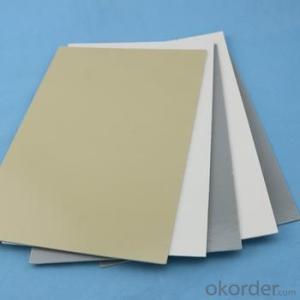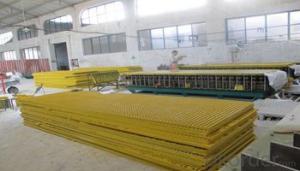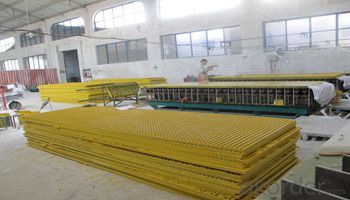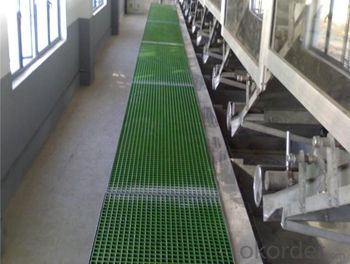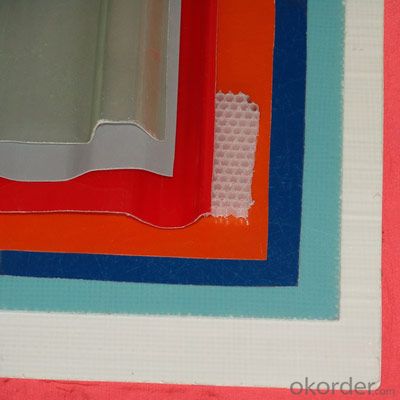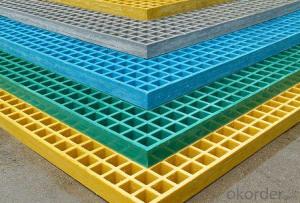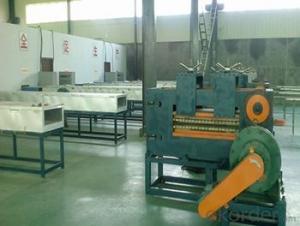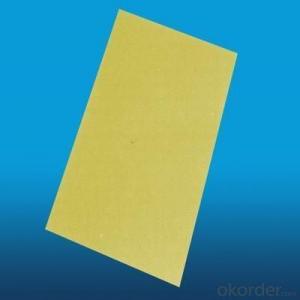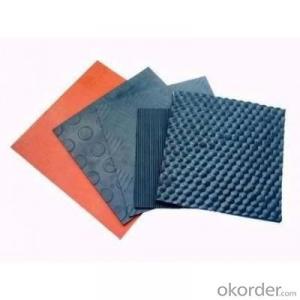Pultruded Fiberglass Flat Panel FRP/GRP Gritted Stripe Sheet
- Loading Port:
- Shanghai
- Payment Terms:
- TT OR LC
- Min Order Qty:
- 50 m
- Supply Capability:
- 80000 m/month
OKorder Service Pledge
OKorder Financial Service
You Might Also Like
Specification
PRODUCT DESCRIPTION
FRP flooring panel is a big size profile which is made by pultrusion technology and in holistic shape, it could
form a continuours close plane by unique self-lock structure,which could be used as load structures in various
corrosion environments and could replace wood plate, aluminum plate or steel plate etc.
The product could add natural color grit on the surface,which is safe for the anti-slippery,besides it could obtain
the natural appearance and no fadding for a long time.
Non Slip Fiberglass skid panel stripes can be used in a multitude of applications - offshore, rail and underground installations. The benefits of using FRP is that is very adaptable and can be manufactured in a variety of non slip surfaces which will lend itself to any environment whether it is stair treads, gangways, grp stair nosings or platforms. These GRP non slip panel stripes are currently being used by the construction, rail, offshore and marine industries with great results.
FEATURES
a. anti-corrosion, non-rusty
b. lightweight and high strength
c. anti-flammable
d. anti-fatigue
e. anti-slippery and safety
f. anti-ageing
g. easy to installation and maintenance
h. excellent electromagnetism property
TECHNICAL DATA
Stiffness | SN3750 | SN5000 | SN10000 | ||||||
Pressure | 0.25 | 0.6 | 1.0 | 0.25 | 0.6 | 1.0 | 0.25 | 0.6 | 1.0 |
400 | 6.1 | 6.1 | 5.9 | 6.7 | 6.7 | 6.4 | 8.1 | 8.1 | 7.87 |
500 | 7.2 | 7.2 | 7.1 | 8 | 8 | 7.7 | 11.4 | 9.6 | 9.4 |
600 | 8.7 | 8.3 | 8.3 | 9.6 | 9.6 | 9.2 | 12.1 | 11.7 | 11 |
700 | 9.7 | 9.7 | 9.4 | 11.2 | 11.2 | 10.4 | 13.8 | 13.2 | 12.5 |
800 | 11.6 | 11.3 | 10.6 | 12.8 | 12.5 | 11.7 | 15.5 | 15 | 14.2 |
900 | 13.4 | 12.5 | 11.7 | 14.8 | 13.8 | 12.9 | 19.3 | 16.4 | 15.8 |
1000 | 14.6 | 13.7 | 13 | 16.2 | 15.1 | 14.4 | 20.7 | 18 | 17.3 |
1100 | 16.1 | 14.9 | 14.2 | 17.9 | 16.5 | 15.6 | 23 | 19.8 | 18.9 |
1200 | 17.2 | 16.1 | 15.4 | 19.6 | 17.9 | 16.9 | 24.7 | 21.5 | 20.6 |
1400 | 20.4 | 18.4 | 17.7 | 22.7 | 20.5 | 19.5 | 29.2 | 24.8 | 23.8 |
1500 | 22 | 19.9 | 18.7 | 24.4 | 22.1 | 20.7 | 31.4 | 26.3 | 25.3 |
1600 | 23.6 | 21.2 | 20 | 26.2 | 23.4 | 22 | 33.7 | 28.2 | 26.9 |
1800 | 26.3 | 23.5 | 22.4 | 29.2 | 26.1 | 24.7 | 36.4 | 31.6 | 30.3 |
2000 | 27.4 | 25.4 | 23.4 | 35 | 32.4 | 29.6 | 44.7 | 37.3 | 36.1 |
2200 | 29.7 | 27.6 | 25.3 | 37.8 | 35.3 | 32.6 | 48.7 | 41.5 | 40.4 |
2400 | 32.6 | 30.3 | 28.4 | 41.8 | 38.8 | 34.6 | 53.4 | 44.6 | 42.8 |
2600 | 36.3 | 33.5 | 31.5 | 45.2 | 40.5 | 35.4 | 55.8 | 47.2 | 45.6 |
2800 | 39.6 | 36.0 | 34 | 49.4 | 45.1 | 42 | 62 | 53 | 51 |
3000 | 41.0 | 38.1 | 36.2 | 52 | 47 | 45.3 | 67 | 58.2 | 54 |
PICTURES
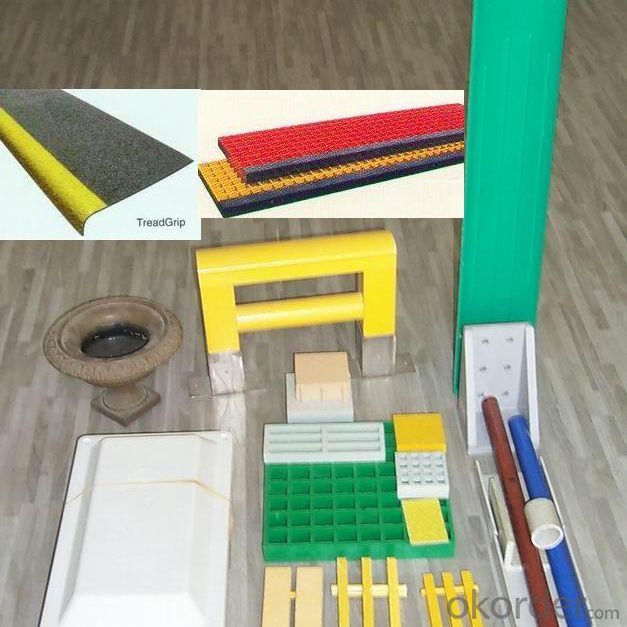
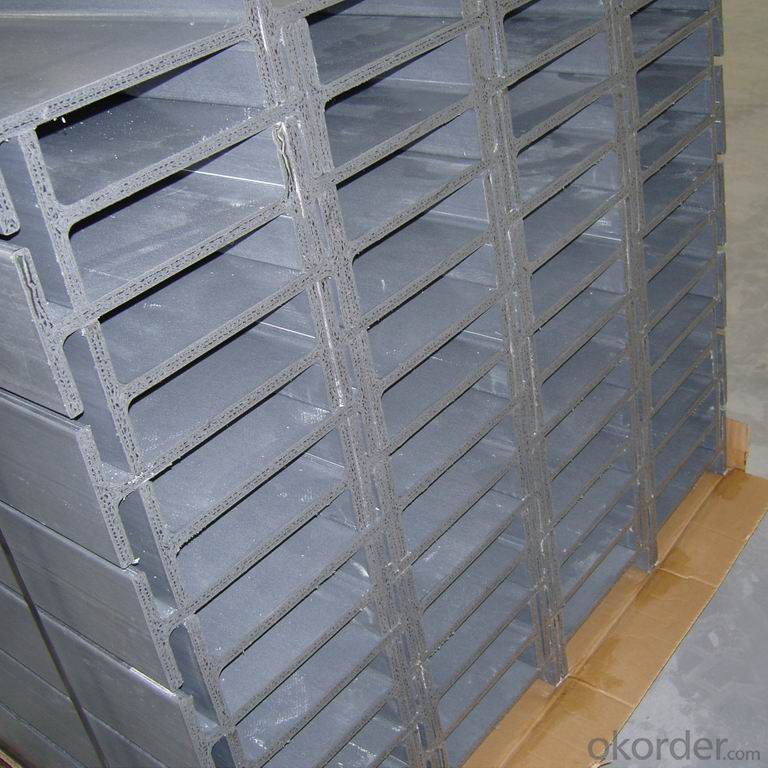
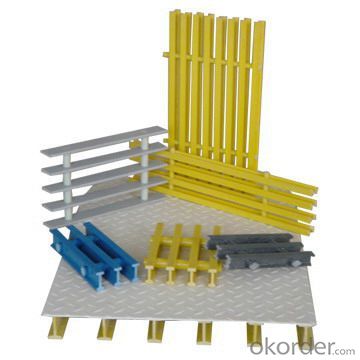
- Q: Are FRP pultrusion profiles resistant to high winds or hurricanes?
- Yes, FRP pultrusion profiles are resistant to high winds and hurricanes. The inherent strength and durability of fiberglass reinforced plastic (FRP) combined with the pultrusion manufacturing process make these profiles highly resistant to extreme weather conditions, including high winds and hurricanes. They have been extensively tested and proven to withstand strong winds and turbulent weather events.
- Q: Are FRP pultrusion profiles resistant to impact from heavy machinery?
- Yes, FRP pultrusion profiles are highly resistant to impact from heavy machinery due to their inherent strength and durability. The strong composite materials used in their construction, such as fiberglass reinforced polymers, provide excellent impact resistance, making them a reliable choice for applications where heavy machinery might be involved.
- Q: Can FRP pultrusion profiles be used in chemical storage tanks?
- Indeed, it is possible to utilize FRP pultrusion profiles in the construction of chemical storage tanks. These profiles are recognized for their exceptional resistance to corrosion, rendering them suitable for the storage of a wide array of chemicals. Moreover, their lightweight nature, strength, and impressive strength-to-weight ratio make them an optimal choice for the creation of robust and long-lasting chemical storage tanks. Furthermore, FRP pultrusion profiles can be tailor-made to fulfill specific design requirements, enabling flexibility in tank design and construction. In summary, due to their corrosion resistance, strength, and customization capabilities, FRP pultrusion profiles emerge as a dependable and cost-efficient alternative for chemical storage tanks.
- Q: What are the best manufacturers of glass fiber reinforced plastic pultruded profiles in China?
- We have made 2.5mm thick at the moment
- Q: Can FRP pultrusion profiles be used in the construction of amusement park rides?
- Yes, FRP (Fiber Reinforced Polymer) pultrusion profiles can be used in the construction of amusement park rides. FRP pultrusion profiles offer numerous advantages that make them suitable for such applications. Firstly, FRP pultrusion profiles are known for their high strength-to-weight ratio. This means that they are significantly lighter than traditional materials like steel while still maintaining excellent structural integrity. As a result, using FRP profiles in amusement park rides can help reduce the overall weight of the structure without compromising on safety. Secondly, FRP pultrusion profiles have excellent corrosion resistance properties. Unlike steel, FRP does not rust or deteriorate when exposed to moisture or chemicals commonly found in amusement park environments. This makes FRP profiles ideal for rides that are constantly exposed to water, humidity, and other harsh conditions. Additionally, FRP pultrusion profiles offer design flexibility. They can be manufactured in various shapes and sizes, allowing for customized designs to meet specific requirements of amusement park rides. This versatility in design enables engineers and designers to create complex and intricate structures that are both aesthetically pleasing and functional. Moreover, FRP pultrusion profiles have excellent electrical insulation properties. This is particularly important for amusement park rides that may have electrical components and wiring, as FRP profiles can provide a high level of safety by preventing electrical conductivity. Furthermore, FRP profiles are non-magnetic, which can be advantageous in amusement park rides that use magnetic systems or sensors. Non-magnetic materials eliminate the risk of interference or disruption to the ride's functionality. Lastly, FRP pultrusion profiles are durable and require minimal maintenance. They are resistant to UV radiation, which means they will not degrade or fade due to prolonged exposure to sunlight. This reduces the need for frequent painting or coating, resulting in lower maintenance costs over time. Overall, the combination of lightweight, corrosion resistance, design flexibility, electrical insulation, non-magnetic properties, and durability make FRP pultrusion profiles an excellent choice for the construction of amusement park rides.
- Q: What are the circumstances in which the pultrusion should be performed?
- The roving yarn assembly in yarn frame, yarn unwinding through a series of guide roller and cluster grid plate, roller set, enter the resin impregnated resin impregnated yarn groove. Then through the pre forming die, the die is required according to the shape of products and configuration in the guiding device. The mold after discharge excess resin and bubbles into the cold. Cold mold cooling by cooling water, so that the resin viscosity, reduce the loss, and finally into the mold, the fiber reinforced material and resin molding in mold curing, and then the traction device is pulled, cut into required length of products by cutting device.
- Q: Can FRP pultrusion profiles be used in the construction of swimming pool enclosures?
- Yes, FRP (Fiber Reinforced Polymer) pultrusion profiles can be used in the construction of swimming pool enclosures. FRP pultrusion profiles are known for their excellent strength-to-weight ratio, corrosion resistance, and durability, making them an ideal choice for outdoor applications like swimming pool enclosures. FRP pultrusion profiles are made by pulling fiberglass rovings through a resin bath and then through a heated die, resulting in a continuous profile of uniform shape and strength. This manufacturing process ensures that the profiles are strong, stiff, and lightweight, making them easy to handle and install. In the construction of swimming pool enclosures, FRP pultrusion profiles can be used for various structural elements such as beams, columns, trusses, and panels. These profiles can provide the necessary strength and support while also offering resistance to corrosion, moisture, and UV radiation, which are common challenges in a swimming pool environment. Additionally, FRP pultrusion profiles can be customized to meet specific design requirements, allowing for flexibility in creating unique and aesthetically pleasing swimming pool enclosures. They can be fabricated in a variety of shapes, sizes, and colors, making it possible to achieve the desired architectural look and feel. Overall, FRP pultrusion profiles offer a reliable and long-lasting solution for constructing swimming pool enclosures, providing the necessary strength, durability, and resistance to environmental factors. Their lightweight nature also makes them easier to handle and install, reducing construction time and costs.
- Q: Can FRP pultrusion profiles be used in the construction of chemical storage tanks?
- Yes, FRP pultrusion profiles can be used in the construction of chemical storage tanks. FRP (Fiber Reinforced Plastic) offers excellent resistance to corrosion, making it a suitable material for storing chemicals. Pultrusion profiles provide structural support and durability, ensuring the tank's integrity. Additionally, FRP's lightweight nature, high strength-to-weight ratio, and customizable design make it an ideal choice for constructing chemical storage tanks.
- Q: Are FRP pultrusion profiles non-conductive?
- FRP pultrusion profiles are non-conductive because they consist of reinforced fibers, usually fiberglass, and a polymer resin matrix. The fiberglass fibers provide strength and stiffness, while the polymer resin acts as a binder. One of the main advantages of FRP pultrusion profiles is their excellent electrical insulation properties. Unlike metals, which conduct electricity, FRP profiles do not. This makes them ideal for applications that require electrical insulation. In addition to being non-conductive, FRP pultrusion profiles also offer other advantages like corrosion resistance, a high strength-to-weight ratio, and low maintenance requirements. These properties make them suitable for various applications such as electrical and telecom infrastructure, chemical processing plants, bridges, and building construction. It is worth noting that while FRP pultrusion profiles are non-conductive by default, they can be made conductive if necessary. Special additives or coatings can be added during the manufacturing process to give them conductive properties.
- Q: Can FRP pultrusion profiles be used in the construction of oil storage tanks?
- Yes, FRP (Fiber Reinforced Polymer) pultrusion profiles can be used in the construction of oil storage tanks. FRP pultrusion profiles offer several advantages in this application. Firstly, FRP is highly resistant to corrosion, which is crucial for oil storage tanks as they are constantly exposed to harsh environmental conditions and the corrosive nature of oil. This makes FRP pultrusion profiles a suitable alternative to traditional construction materials like steel, which is prone to corrosion and requires frequent maintenance. Additionally, the lightweight nature of FRP pultrusion profiles makes them easier to handle and install compared to heavy steel components. This reduces construction time and costs, making FRP an attractive option for oil storage tank construction. Furthermore, FRP pultrusion profiles offer excellent strength and durability, ensuring the structural integrity of the oil storage tanks. The material's high strength-to-weight ratio allows for efficient load-bearing and structural performance. Moreover, FRP pultrusion profiles can be customized to meet specific design requirements, allowing for flexibility in tank design and construction. The pultrusion process enables the production of complex shapes and sizes, providing engineers with the ability to optimize the tank's design for maximum efficiency. Lastly, FRP is non-conductive and has high electrical resistance, making it a safe choice for oil storage tanks. This eliminates the risk of electrical hazards that may occur in tanks constructed with conductive materials. In conclusion, FRP pultrusion profiles can indeed be used in the construction of oil storage tanks, offering numerous advantages such as corrosion resistance, lightweight construction, high strength, design flexibility, and electrical safety.
Send your message to us
Pultruded Fiberglass Flat Panel FRP/GRP Gritted Stripe Sheet
- Loading Port:
- Shanghai
- Payment Terms:
- TT OR LC
- Min Order Qty:
- 50 m
- Supply Capability:
- 80000 m/month
OKorder Service Pledge
OKorder Financial Service
Similar products
Hot products
Hot Searches
Related keywords
